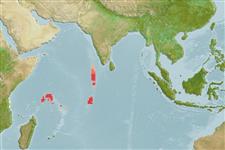>
Gobiiformes (Gobies) >
Gobiidae (Gobies) > Gobiinae
Etymology: Stonogobiops: Greek, stonos, -ou = groan + Latin, gobius = gudgeon + Greek, ops = appearance (Ref. 45335).
Environment: milieu / climate zone / depth range / distribution range
Écologie
marin récifal; profondeur 15 - 37 m (Ref. 9360), usually 20 - ? m (Ref. 30404). Tropical; 10°N - 10°S
Western Indian Ocean: Seychelles, Maldives.
Taille / Poids / Âge
Maturity: Lm ? range ? - ? cm
Max length : 7.0 cm TL mâle / non sexé; (Ref. 30404)
Épines dorsales (Total): 7; Rayons mous dorsaux (Total): 10; Épines anales 1; Rayons mous anaux: 9; Vertèbres: 26. Eyes and mouth large. Head yellow anteriorly and dorsally, white posteriorly; broad, diagonal bar from ventroposterior part of head to nape; 5 head pores. White interspaces on body bisected by orange-red line. First dark bar of body continued into the first, round dorsal fin; 2nd dorsal, anal and caudal fins pale whitish. Pectoral fins pointed. No scales on thorax and pectoral base. Angle of jaws 35 degrees. Palatines with tooth-like processes. Longitudinal scale series 84-94, transverse 26-32. Naked median predorsal region.
Inhabits open sand and rubble zones adjacent to reefs (Ref. 30404). Occurs in pairs and hovers above the burrow entrance. Lives symbiotically with Alpheus randalli (Ref. 9360).
Life cycle and mating behavior
Maturité | Reproduction | Frai | Œufs | Fécondité | Larves
Hoese, D.F. and J.E. Randall, 1982. Revision of the Indo-Pacific gobiid fish genus Stonogobiops. Indo-Pac. Fish. (1):18 p. (Ref. 397)
Statut dans la liste rouge de l'IUCN (Ref. 130435)
Menace pour l'homme
Harmless
Utilisations par l'homme
Plus d'informations
PaysZones FAOÉcosystèmesOccurrencesIntroductionsStocksÉcologieRégime alimentaireÉléments du régime alimentaireConsommation alimentaireRation
Noms communsSynonymesMétabolismePrédateursÉcotoxicologieReproductionMaturitéFraiRassemblement de ponteFéconditéŒufsDéveloppement de l'œuf
RéférencesAquacultureProfil d'aquacultureSouchesGénétiqueElectrophoresesHéritabilitéPathologiesTraitementNutrientsMass conversion
Outils
Articles particuliers
Télécharger en XML
Sources Internet
Estimates based on models
Preferred temperature (Ref.
123201): 20 - 28.2, mean 27.6 °C (based on 8 cells).
Phylogenetic diversity index (Ref.
82804): PD
50 = 0.5078 [Uniqueness, from 0.5 = low to 2.0 = high].
Bayesian length-weight: a=0.01023 (0.00477 - 0.02194), b=3.02 (2.84 - 3.20), in cm total length, based on LWR estimates for this (Sub)family-body shape (Ref.
93245).
Niveau trophique (Ref.
69278): 3.2 ±0.3 se; based on size and trophs of closest relatives
Résilience (Ref.
120179): Haut, temps minimum de doublement de population inférieur à 15 mois (Preliminary K or Fecundity.).
Fishing Vulnerability (Ref.
59153): Low vulnerability (10 of 100).
